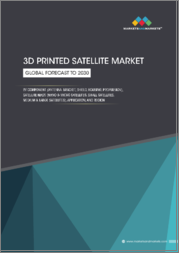
|
시장보고서
상품코드
1577295
항공우주 3D 프린팅 재료 시장, 기회, 성장 촉진요인, 산업 동향 분석과 예측(2024-2032년)Aerospace 3D Printing Materials Market, Opportunity, Growth Drivers, Industry Trend Analysis and Forecast, 2024-2032 |
||||||
세계의 항공우주 3D 프린팅 재료 시장은 2024-2032년에 12.1% 이상의 성장 페이스를 나타냅니다.
이 시장은 항공우주 산업에서 3D 프린팅을 위해 설계된 특수 재료의 생산 및 사용에 초점을 맞추었습니다. 이 시장을 주도하는 것은 빠르고 복잡한 디자인의 경량, 고강도 부품의 신속한 제조로 비용 절감과 성능상의 이점을 가져다주는 것입니다.
항공우주 분야에서는 경량화 및 고강도 부품의 끊임없는 추구로 인해 3D 프린팅 기술에 대한 의존도가 높아지고 있습니다. 이러한 기술은 복잡한 형상의 신속한 제조를 가능하게 할 뿐만 아니라, 상당한 비용 절감을 약속합니다. 또한 항공우주 분야의 기술 혁신이 진행됨에 따라 3D 프린팅에 맞게 조정된 특수 소재에 대한 수요도 증가하고 있습니다. 이러한 추세는 3D 프린팅 기술의 발전으로 인해 더욱 증폭되고 있으며, 3D 프린팅 기술은 더욱 접근성이 뛰어나고 효율성이 높아져 항공우주 분야에 선호되는 선택이 되고 있습니다.
플라스틱 소재 부문은 연평균 12% 이상 성장하여 2032년까지 5억 1,480만 달러에 달할 것으로 예상됩니다. 플라스틱은 가볍고 비용 효율적이기 때문에 내장 부품 및 프로토타입과 같은 구조적 및 비구조적 용도 모두에서 선호되고 있습니다. 항공우주 산업이 기술 혁신과 성능 향상을 추구함에 따라 구조용 및 비구조용 플라스틱의 적응성이 가장 중요한 요소로 떠오르고 있습니다. 항공우주 분야에서 플라스틱에 대한 인식과 의존도가 높아짐에 따라 3D 프린팅 재료 시장 수요 증가를 견인하고 있습니다.
부품 제조 부문은 약 12.1%의 연평균 복합 성장률(CAGR)로 성장하여 2032년까지 4억 4,970만 달러 규모에 도달할 것으로 예상됩니다. 이러한 재료는 엔진 노즐 및 벽면 패널과 같은 부품에 널리 사용됩니다. 이러한 부품에 대한 수요는 산업용 프린터 크기의 발전, 재료 유형 증가, 처리 시간을 최적화하기 위한 연구개발 자금 증가로 인해 급증하고 있습니다. 이 기술을 통해 기존 방식에 비해 탄력성이 강화된 복잡하고 가벼운 부품을 만들 수 있습니다.
북미 항공우주 3D 프린팅 재료 시장은 2032년까지 약 4억 3,100만 달러 규모로 연평균 12.2%의 성장률을 나타낼 것으로 예상됩니다. 이 지역의 강력한 항공우주 부문과 3D 프린팅 기술의 발전이 이러한 성장을 주도하고 있습니다. 항공기, 우주선, 방위 산업을 위한 티타늄 합금 및 첨단 복합재와 같은 고성능 소재에 대한 관심이 높아지고 있습니다. 정부의 기술 혁신에 힘입어 주요 항공우주 기업은 시제품 제작과 생산 모두에서 적층제조에 점점 더 많은 관심을 기울이고 있습니다. 항공기 경량화 및 연비 향상에 중점을 둔 북미는 세계 항공우주 3D 프린팅 재료 시장의 선두주자로 자리매김하고 있습니다.
목차
제1장 조사 방법과 조사 범위
제2장 개요
제3장 업계 인사이트
- 에코시스템 분석
- 주요 제조업체
- 유통업체
- 업계 전체의 이익률
- 업계에 대한 영향요인
- 항공 산업의 성장과 연비 효율이 높은 항공기에 대한 수요 증가
- 항공기
- 항공우주 산업에서 소량 생산의 요구 증가
- 우주 탐사와 방위 산업의 추진
- 시장이 해결해야 할 과제
- 높은 재료 비용
- 엄격한 인증 요건
- 시장 기회
- 새로운 기회
- 성장 가능성 분석
- 원재료 사정
- 제조 동향
- 기술의 진화
- 지속가능 제조
- 그린 프랙티스
- 탈탄소화
- 지속가능 제조
- 원재료의 지속가능성
- 가격 동향(달러/톤), 2021-2032년
- 규제와 시장에 대한 영향
- Porter의 산업 분석
- PESTEL 분석
제4장 경쟁 구도
- 기업 점유율 분석
- 경쟁 포지셔닝 매트릭스
- 전략 전망 매트릭스
제5장 시장 규모·예측 : 재료별, 2021-2032년
- 주요 동향
- 플라스틱
- 필라멘트
- PEI
- ABS
- PC 및 블렌드
- 기타(PLA, TPU, 나일론)
- 파우더
- TPU
- PEEK
- 폴리아미드
- PEKK
- 필라멘트
- 금속
- 티타늄
- 알루미늄
- 인코넬
- 기타(코발트 크롬, 스테인리스)
- 세라믹
- 기타(그래핀, 복합재)
제6장 시장 규모·예측 : 항공기 부품별, 2021-2032년
- 주요 동향
- 엔진
- 구조 부품(보디, 객실 내장품)
- 지그·고정구
제7장 시장 규모·예측 : 용도별, 2021-2032년
- 주요 동향
- 항공기
- 일반·민간 항공기
- 군·방위
- 우주선
제8장 시장 규모·예측 : 지역별, 2021-2032년
- 주요 동향
- 북미
- 미국
- 캐나다
- 유럽
- 독일
- 영국
- 프랑스
- 이탈리아
- 스페인
- 기타 유럽
- 아시아태평양
- 중국
- 인도
- 일본
- 한국
- 호주
- 기타 아시아태평양
- 라틴아메리카
- 브라질
- 멕시코
- 아르헨티나
- 기타 라틴아메리카
- 중동 및 아프리카
- 사우디아라비아
- UAE
- 남아프리카공화국
- 기타 중동 및 아프리카
제9장 기업 개요
- Stratasys Ltd
- 3D Systems, Inc
- GE
- ExOne
- Hoganas AB
- EOS
- Materialise
- Norsk
The Global Aerospace 3D Printing Materials Market will exhibit over 12.1% growth pace during 2024-2032. This market focuses on the production and use of specialized materials, designed for 3D printing in the aerospace industry. The push for lightweight, high-strength components, produced quickly and with intricate designs, drives this market, offering notable cost savings and performance benefits.
The relentless pursuit of lightweight and high-strength components in aerospace sector has led to an increased reliance on 3D printing technologies. These technologies not only allow for the swift production of intricate geometries but also promise significant cost savings. Furthermore, as the aerospace sector continues to innovate, the demand for specialized materials tailored for 3D printing is on the rise. This trend is amplified by advancements in 3D printing technologies, which are becoming more accessible and efficient, making them a preferred choice for aerospace applications.
The Aerospace 3D Printing Materials Market is segmented based on material, application, aircraft parts, end use , and region.
The plastic material segment is projected to reach USD 514.8 million by 2032, growing at a CAGR of over 12%. Due to their lightweight and cost-effective nature, plastics are favored in both structural and non-critical aerospace applications, such as interior components and prototypes. As the aerospace industry seeks to innovate and enhance performance, the adaptability of plastics in both structural and non-critical roles becomes paramount. This growing recognition and reliance on plastics in the aerospace sector are driving their heightened demand in the 3D printing materials market.
The part production segment is expected to grow at a CAGR of around 12.1%, reaching a market size of USD 449.7 million by 2032. These materials are widely used for components like engine nozzles and wall panels. Demand for these parts has surged due to advancements in industrial printer sizes, a wider range of materials, and increased R&D funding to optimize turnaround times. This technology allows for the creation of intricate, lightweight parts with enhanced resilience compared to traditional methods.
North America aerospace 3D printing materials market is projected to reach a size of about USD 431 million by 2032, growing at a CAGR of 12.2%. The region's strong aerospace sector and advancements in 3D printing technology drive this growth. There is focus on high-performance materials, such as titanium alloys and advanced composites, for aircraft, spacecraft, and defense. Major aerospace companies, backed by government innovations, are increasingly turning to additive manufacturing for both prototyping and production. With a regional emphasis on reducing aircraft weight and boosting fuel efficiency, North America cements its status as a leader in the global aerospace 3D printing materials market.
Table of Contents
Chapter 1 Methodology and Scope
- 1.1 Market scope and definition
- 1.2 Base estimates and calculations
- 1.3 Forecast calculation
- 1.4 Data sources
- 1.4.1 Primary
- 1.4.2 Secondary
- 1.4.2.1 Paid sources
- 1.4.2.2 Public sources
Chapter 2 Executive Summary
- 2.1 Industry 360° synopsis
Chapter 3 Industry Insights
- 3.1 Industry ecosystem analysis
- 3.1.1 Key manufacturers
- 3.1.2 Distributors
- 3.1.3 Profit margins across the industry
- 3.2 Industry impact forces
- 3.2.1 Proliferating aviation industry coupled with rising demand for fuel-efficient
- 3.2.2 Aircrafts
- 3.2.3 Growing need for low volume production from aerospace industry
- 3.2.4 Propelling space exploration and defense industry
- 3.2.5 Market challenges
- 3.2.5.1 High material cost
- 3.2.5.2 Stringent certification requirements
- 3.2.6 Market opportunity
- 3.2.6.1 New opportunities
- 3.2.6.2 Growth potential analysis
- 3.3 Raw material landscape
- 3.3.1 Manufacturing trends
- 3.3.2 Technology evolution
- 3.3.2.1 Sustainable manufacturing
- 3.3.2.1.1 Green practices
- 3.3.2.1.2 Decarbonization
- 3.3.2.1 Sustainable manufacturing
- 3.3.3 Sustainability in raw materials
- 3.3.4 Pricing trends (USD/Ton), 2021 - 2032
- 3.3.4.1 North America
- 3.3.4.2 Europe
- 3.3.4.3 Asia Pacific
- 3.3.4.4 Latin America
- 3.3.4.5 Middle East and Africa
- 3.4 Regulations and market impact
- 3.5 Porter's analysis
- 3.6 PESTEL analysis
Chapter 4 Competitive Landscape, 2023
- 4.1 Company market share analysis
- 4.2 Competitive positioning matrix
- 4.3 Strategic outlook matrix
Chapter 5 Market Size and Forecast, By Material, 2021-2032 (USD Million, Kilo Tons)
- 5.1 Key trends
- 5.2 Plastic
- 5.2.1 Filament
- 5.2.1.1 PEI
- 5.2.1.2 ABS
- 5.2.1.3 PC and Blends
- 5.2.1.4 Others (PLA, TPU, Nylon)
- 5.2.2 Powder
- 5.2.2.1 TPU
- 5.2.2.2 PEEK
- 5.2.2.3 Polyamides
- 5.2.2.4 PEKK
- 5.2.1 Filament
- 5.3 Metals
- 5.3.1 Titanium
- 5.3.2 Aluminum
- 5.3.3 Inconel
- 5.3.4 Others (Cobalt-chrome, Stainless steel)
- 5.4 Ceramic
- 5.5 Others (Graphene, Composites)
Chapter 6 Market Size and Forecast, By Aircraft Parts, 2021-2032 (USD Million, Kilo Tons)
- 6.1 Key trends
- 6.2 Engine
- 6.3 Structural Components (Body and Cabin Interiors)
- 6.4 Jigs and Fixtures
Chapter 7 Market Size and Forecast, By End-Use, 2021-2032 (USD Million, Kilo Tons)
- 7.1 Key trends
- 7.2 Aircraft
- 7.2.1 General and Commercial Aviation
- 7.2.2 Military and Defense
- 7.3 Spacecraft
Chapter 8 Market Size and Forecast, By Region, 2021-2032 (USD Million, Kilo Tons)
- 8.1 Key trends
- 8.2 North America
- 8.2.1 U.S.
- 8.2.2 Canada
- 8.3 Europe
- 8.3.1 Germany
- 8.3.2 UK
- 8.3.3 France
- 8.3.4 Italy
- 8.3.5 Spain
- 8.3.6 Rest of Europe
- 8.4 Asia Pacific
- 8.4.1 China
- 8.4.2 India
- 8.4.3 Japan
- 8.4.4 South Korea
- 8.4.5 Australia
- 8.4.6 Rest of Asia Pacific
- 8.5 Latin America
- 8.5.1 Brazil
- 8.5.2 Mexico
- 8.5.3 Argentina
- 8.5.4 Rest of Latin America
- 8.6 MEA
- 8.6.1 Saudi Arabia
- 8.6.2 UAE
- 8.6.3 South Africa
- 8.6.4 Rest of MEA
Chapter 9 Company Profiles
- 9.1 Stratasys Ltd
- 9.2 3D Systems, Inc
- 9.3 GE
- 9.4 ExOne
- 9.5 Hoganas AB
- 9.6 EOS
- 9.7 Materialise
- 9.8 Norsk



















